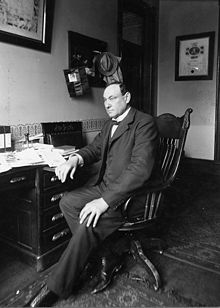User:Remember/FDA
Quick sandbox[edit]
Beginning as the Division of Chemistry and then (after July 1901) the Bureau of Chemistry, the modern era of the FDA dates to 1906 with the passage of the Federal Food and Drugs Act; this added regulatory functions to the agency's scientific mission. The Bureau of Chemistry's name changed to the Food, Drug, and Insecticide Administration in July 1927, when the non-regulatory research functions of the bureau were transferred elsewhere in the department. In July 1930 the name was shortened to the present version.
Dr. Harvey W. Wiley | |
|---|---|
 Dr. Harvey W. Wiley | |
| 1st Commissioner of the Food and Drug Administration | |
| In office March 22, 1935 ?????? – May 2, 1972???????? | |
| President | Franklin D. Roosevelt Harry S. Truman Dwight D. Eisenhower John F. Kennedy Lyndon B. Johnson Richard Nixon????????? |
| Preceded by | Office created (was BOI director)?????????? |
| Succeeded by | L. Patrick Gray??????????????? |
| 6th Director of the Bureau of Investigation????????? | |
| In office May 10, 1924??????????? – March 22, 1935??????????????? | |
| President | Calvin Coolidge Herbert Hoover Franklin D. Roosevelt???????????? |
| Preceded by | William J. Burns?????????????? |
| Succeeded by | Became FBI director??????????????? |
| Personal details | |
| Born | October 30, 1844 Kent, Indiana |
| Died | June 30, 1930 (aged 85) Washington, D.C. |


Carl L. Alsberg | |
|---|---|
| 2nd Commissioner of Food and Drugs | |
| In office 12/16/1912–7/15/1921 | |
| President | William Howard Taft |
| Preceded by | Harvey Washington Wiley |
| Personal details | |
| Born | 1877 |
Carl L. Alsberg, M.D. (1877-1940) was best known for being the second chief of the Bureau of Chemistry from 1912–1921. This position would later morph into the position of the commissioner for the food and drug administration.
From FDA page[edit]
Source Carl L. Alsberg, M.D. 12/16/1912 - 7/15/1921
Carl L. Alsberg was born in New York in 1877.[1] Alsberg received his medical degree from Columbia University in 1900.[1] After graduating he conducted extensive research in Germany with a focus on biochemistry.[1] After returning to the United States he became a junior faculty member at Harvard Medical School.[1]
Unrevised[edit]
From 1908 to 1912 he was a chemical biologist with the Bureau of Plant Industry in the U. S. Department of Agriculture, and in 1912 he succeeded Harvey Wiley as chief of the Bureau of Chemistry, a position he remained in until 1921. Alsberg's tenure at the Bureau of Chemistry was characterized by increasing the attention given to drug regulation, to research, and to an enforcement philosophy that relied more on education and persuasion than prosecution.
After leaving the Bureau of Chemistry, Alsberg joined the faculty of Stanford, where he was Director of the Food Research Institute from 1921 until his retirement, and Dean of Graduate Study from 1927 to 1933. His scientific and professional standing was recognized in part by his presidency of the Society of Biological Chemistry, his membership on the editorial board of the Annual Review of Biochemistry, and his position as the first editor of the Journal of the Association of Official Agricultural Chemists. Alsberg, the youngest of the sixteen men to lead the Bureau of Chemistry and the FDA, died in 1940.
Time as Chief of the Bureau of Chemistry 1912–1921[edit]
In 1912, Alsberg succeeded Harvey Wiley as chief of the Bureau of Chemistry, a position he remained in until 1921.
After being Chief[edit]
After leaving the Bureau of Chemistry, Alsberg joined the faculty of Stanford University, where he was Director of the Food Research Institute from 1921 until his retirement, and Dean of Graduate Study from 1927 to 1933. His scientific and professional standing was recognized in part by his presidency of the Society of Biological Chemistry, his membership on the editorial board of the Annual Review of Biochemistry, and his position as the first editor of the Journal of the Association of Official Agricultural Chemists. Alsberg, the youngest of the sixteen men to lead the Bureau of Chemistry and the FDA, died in 1940.
Margaret Ann "Peggy" Hamburg (born on July 12, 1955) is an American physician and public health administrator. She has served as Vice President for Biological Programs, Nuclear Threat Initiative, Assistant Secretary for Planning and Evaluation of U.S. Department of Health and Human Services, and the New York City Commissioner of Health.[2] She was nominated in March 2009 by President Barack Obama to become the Commissioner of the U.S. Food and Drug Administration.[3] She was sworn in as the Commissioner of the FDA on May 22, 2009.[4]
Hamburg's mother, Beatrix, was the first African-American woman to attend Vassar College and to earn a degree from the Yale University School of Medicine and her father, David, had a career in academic medicine and mental illness research, public policy, and philanthropic leadership. She is married to artificial intelligence researcher Peter Fitzhugh Brown, with whom she has two children.[5]
References[edit]
- ^ a b c d "Carl L. Alsberg, M.D." Food and Drug Adminisration. Food and Drug Adminisration. 2009-06-04. Retrieved 2010-09-20.
- ^ "Profile: Margaret A. Hamburg". Forbes. 2007. Retrieved 2009-03-12.
- ^ Gardiner Harris (11 March 2009). "Ex-New York Health Commissioner Is F.D.A. Pick". The New York Times. Retrieved 2009-03-12.
- ^ "FDA commissioner". US FDA. Retrieved 2009-05-27.
- ^ Office of Research on Women's Health (25 March 2004). "Dr. Margaret Hamburg". Changing the Face of Medicine. National Institutes of Health. Retrieved 2009-03-06.
External links[edit]
{{DEFAULTSORT:Hamburg, Margaret A.}} [[Category:1955 births]] [[Category:Living people]] [[Category:American physicians]] [[Category:People in public health]] [[Category:Harvard Medical School alumni]] [[Category:Radcliffe College alumni]] [[Category:Women physicians]]
